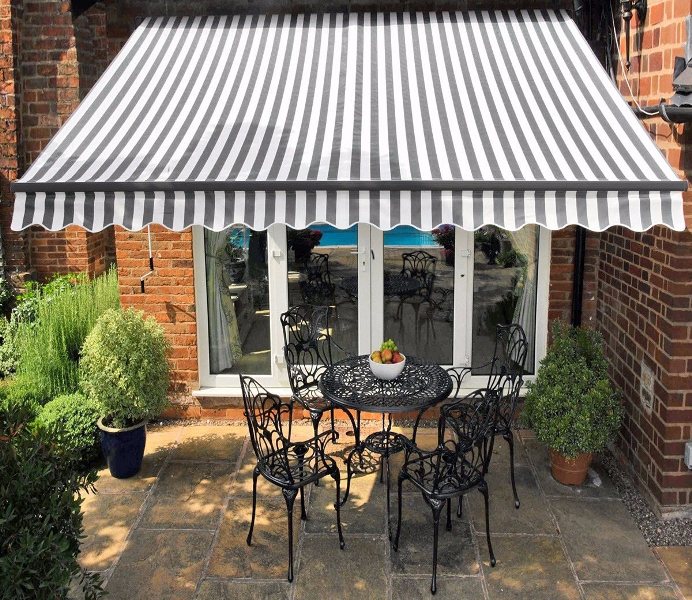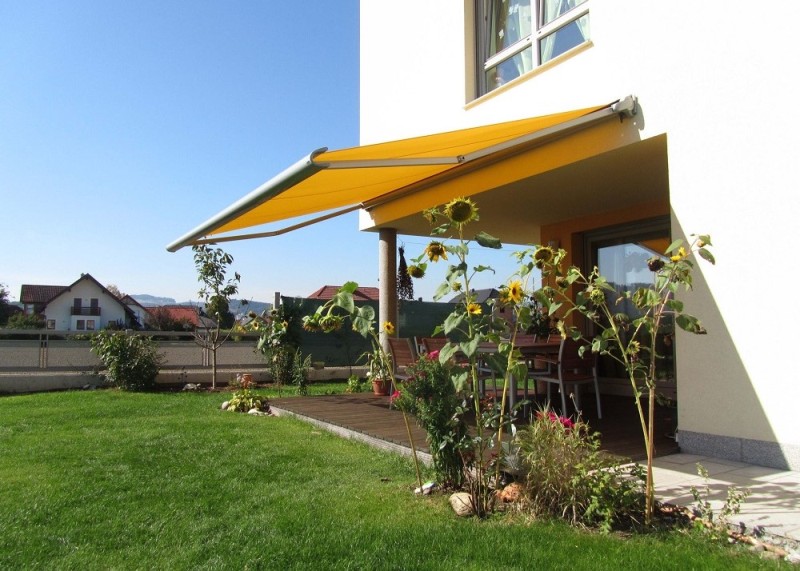Awnings are designed to provide a shade solution. They simply provide protection from the sun to the area they protect. The area they provide shade for isn’t just the area underneath the awning. Their protection is extended to the adjoining rooms. Patio Awnings are simply designed to protect you from the harmful UV rays.
Also, you have to keep in mind that the protection offered by awnings isn’t limited to you and other humans. This is obvious as modern awnings are mostly easy to install awnings that confers protection on your property. In layman terms, these devices protect your furniture, and furnishings from bleaching under the intense glare of sunlight.
A third advantage of having an awning like the drop arm awning installed is the privacy it confers. Neighbours with overlooking buildings can be nosy and monitor your affairs from their perch. With the dimensions and design of an awning, it becomes harder for them to do this.
Patio Awnings Size?

For a patio awning to function optimally, you have to take its width and depth into consideration. These two factors are important when choosing a patio awning. There is a general rule that your decision should follow. It goes thus:
Width
The smallest of patio awnings should be at least 500mm wider than the door at each side. That is a total of 1000mm width as an absolute minimum. To understand this better, if you have a 2500m wide set of doors, your patio awning width must be at least 3500mm. This ensures that the shading function is not limited to the region beneath the awning.
Depth
The projection – arm size of the awning should be determined by where you are installing your awning. For internal shading, you can go lower than 3000mm for your projection. However, if the patio awning is installed outdoors, your projection ideally, has to be higher than this.
Setting Up Your Patio Awning
A typical patio awning is installed with a minimum pitch of 14 degrees. This is the lowest pitch where the awning can serve as a sun shade as well as offering protection from rain and wind.
The patio awning is set at an angle that is determined by the front profile and the amount of mounting space available. The angle ast which the patio awning is set can be as shallow as 5 degrees. Some can be set at an angle as high as 38 degrees also. It all comes down to preference. However, you should know that a high degree of installation combined with a low front profile helps to optimally maximize the degree of sun protection provided by the awning
Can Patio Awning Offer Protection From Rain?

Although patio awnings are designed with the purpose of serving as protection from the harmful UV rays, they can also be used for protection against the occasional rain. For a patio awning to serve this function, it has to pass the European standard EN13561 and must have a minimum pitch of 14 degrees. The pitch ensures that the rainwater isn’t collected by the awning fabric. Instead, the water runs off and is dropped.
If you use your electric awning to protect yourself from the rain, allow the fabric to dry before retracting the fabric. This reduces the rippling effect and quantity of waviness in the fabric material. Also, minimise the number of times you use your awning as a rain shield. This helps your fabric last longer.
Can Patio Awning Offer Protection From Wind?
A standard patio awning is constructed to withstand strong breeze. Even, they can stand firm in the face of the occasional gust of wind. The question now is how do you recognize wind that the patio awning isn’t designed to withstand? These devices cannot withstand winds that have a speed greater than 30mph. You should retract your awning in adverse weather conditions like thunderstorms, lightnings, and days characterized with strong snowing, hale and frost. Your awning isn’t designed for this condition.
When you are not sure of the weather conditions, ask yourself the following questions. Are you sitting comfortably beneath your patio awning? Is the awning fabric rippling? Do your feel like your jacket might be blown off? If you feel perfectly comfortable and the answer to the latter two questions is No, then you can leave your awning out there. If you are not sure however, retract your awning before it sustains any damage.






